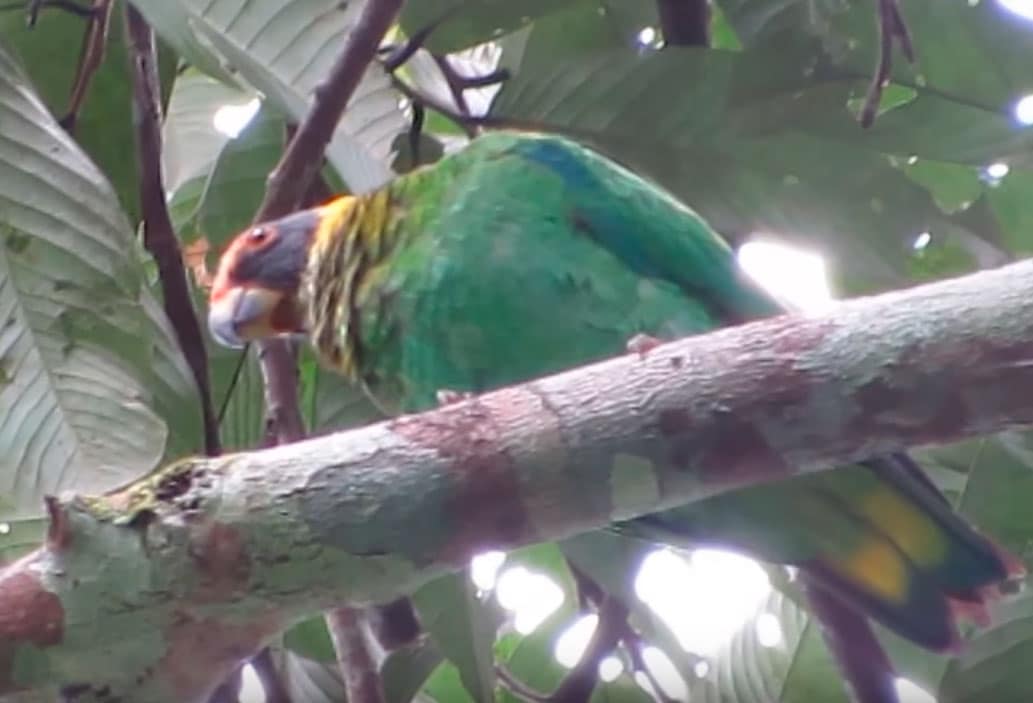Content |
|---|
Description:
23 cm.. length and a weight between 138-165 g..
The Vulturine Parrot (Pyrilia vulturina) It is a small parrot with bare skin yellow orange and covered bristles pale hairlike, in the area that covers the forecrown and back of the crown, until the eyes; bare skin on lores, the cheeks and center of crown black and covered with bristles black hairlike; feathers on the sides of neck and in the part back from the crown, are yellow, forming a band bright contrasting with the black of the head bare; back of the neck, black; upperparts green.
carpal area and lesser upperwing-coverts, orange-yellow; outer median coverts with some blue; leading edge of wing, red; primary coverts blue; rest of the upper parts of the wings, green.
Primaries bluish-black with narrow bluish-green margins to outerweb. Under, the wings with coverts red; flight feather green with blackish tips. feathers throat and the chest, olive yellow with dark tips, giving a scalloped effect; belly green with bluish tint; undertail-coverts brighter yellowish green. Tail green with tips blue and outer feathers with yellow on base of innerwebs. Bill dark blackish-grey with patch pale yellow at the base of the upper jaw; cere yellowish-horn; irises brownish-orange; legs grey.
Both sexes are similar.
The head of the immature, fully feathered (except in the eye ring); greenish on the cheeks and yellow olive in the rest of the head with no collar yellow. The bend of wing and underwing-coverts, yellowish-orange; irises darker.
- Sound of the Vulturine Parrot.
Habitat:
It inhabits in the rainforest of lowland formations várzea (seasonally flooded forest), and the Mainland (without flooding). Gregarious.
Reproduction:
No details on the reproductive biology of this species.
Food:
diet includes fruit, seeds and berries taken in the forest canopy. Its bareheaded adaptation may be a high frugivore diet, to prevent the fruit pulp enmarañara their feathers.
Distribution and status:
Size of its range (breeding/resident ): 1.030.000 km2
endemic to northeast Brazil, to the South of the amazon, from the eastern state of amazon, on the east bank of Madeira River, passing by For, to the south, up to the Serra do Cachimbo, extending eastward to the areas bordering northwest Maranhão, in the region of the Gurupi River. May be restricted to areas around major rivers within this region, which would mean that the size of the range may be overestimated.
References in relation to its range to include Venezuela (lower basin Caura River) and Guyana, They are apparently wrong.
generally considered Rare, although undoubtedly they not have a lot of data due to the difficulty of observation of this species.
The continuing rapid deforestation throughout its range has had to contribute to a substantial decrease in the population Vulturine Parrot in the last decades.
They can be seen in protected forests in the west of its range, but illegal logging and colonization remain a threat even there.
Conservation:
• Current category of the Red List of the UICN: Vulnerable.
• Population trend: Decreasing.
Rationale for the Red List category
Based on a model of future deforestation in the amazon basin and its dependence on primary forest and sensitivity to fragmentation, It is suspected that population of this species will decrease rapidly during the next three generations and, therefore, It has risen to Vulnerability.
Justification of the population
The population size World has not been quantified, but this species is described as “Rare” (Stotz et to the ., 1996).
Justification of trend
It is suspected that this species has lost 37,1-54,8% of habitat within its distribution over three generations (21 years) starting from a model of deforestation Amazon (Soares-Filho et to the ., 2006, Bird et to the ., 2011). Although the species may have some susceptibility to hunting and / or capture, also it appears to have some degree of tolerance habitat degradation (A. Lees in litt ., 2011). So, you suspect your population decline by 30-49% during three generations.
"Vulturine Parrot" in captivity:
It is not found in aviculture; Probably they never stood outside Brazil.
Alternative names:
– Vulturine Parrot (English).
– Caïque vautourin (French).
– Kahlkopfpapagei (German).
– curica-urubu, papagaio-urubu, periquito d’anta, periquito-urubu, pirí-pirí, urubu-paraguá (Portuguese).
– Lorito Cabeza Zamuro, Lorito Vulturino (español).
scientific classification:

– Order: Psittaciformes
– Family: Psittacidae
– Genus: Pyrilia
– Scientific name: Pyrilia vulturina
– Citation: (Kuhl, 1820)
– Protonimo: Psittacus vulturinus
Images “Vulturine Parrot”:
Videos Lorito Vulturino:
“Vulturine Parrot” (Pyrilia vulturina)
Sources:
- Avibase
- Parrots of the World – Forshaw Joseph M
- Parrots A Guide to the Parrots of the World – Tony Juniper & Mike Parr
- Birdlife
-
Photos:
(1) – Pyrilia vulturina (adult and immature) – Imagen de Parrots A Guide to the Parrots of the World – Tony Juniper & Mike Parr
(2) – Pyrilia vulturina ( Curica Vulture) by victor castro



